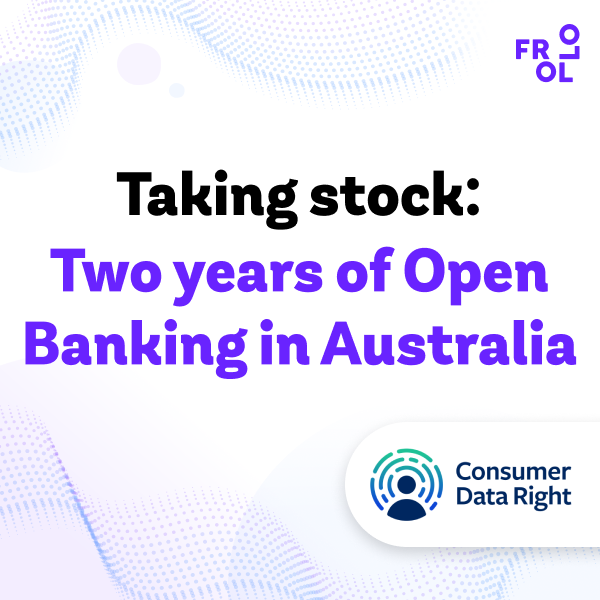
Taking stock: Two years of Open Banking in Australia
Today is the second anniversary of the Consumer Data Right (CDR), the Australian regime that gives consumers the right to share their data between service providers of their choosing, starting with the banking sector (Open Banking).
For Frollo, this means we’ve been using CDR to power our money management app for two years and helping build CDR for nearly three.
Going all-in on Open Banking
As a young fintech, we (Frollo) went all-in on Open Banking because we believed then, and still do today, that it is a gamechanger for the Australian financial sector and it enables us to deliver on our mission to help people feel good about money.
“The importance of Open Banking’s built-in security, transparency and privacy protections shouldn’t be underestimated.”
We see clearly the potential of Open Banking to disrupt financial services and improve the lives of Australians. Access to reliable, rich, real-time financial data has enabled us to build next-generation financial well-being and lending experiences. In addition, the value of Open Banking’s security, transparency, and privacy protections compared to traditional ways of sharing financial data shouldn’t be underestimated. Consumers tell us they value it, and we see their preference in the increased take-up rates of Open Banking compared to screen scraping (more than double!).
Today more than 100 banks share data for over 30 financial products. APIs are lightning-fast and very reliable. And we’re already looking ahead at Open Finance, which will likely include non-bank lenders, Buy Now Pay Later providers and superannuation funds as Data Holders. For context, the UK is now four years into Open Banking and has just started looking at including mortgages, personal loans and savings accounts.
Unlocking Open Banking’s potential
Regardless of our excitement about the future, it’s clear that Open Banking isn’t where we’d hoped it would be today. There are data issues, the user experience isn’t always great, and after two years, Frollo is still the only one doing Open Banking at any scale in Australia (even though 31 businesses are registered to use Open Banking data).
We have work to do for Open Banking to deliver on its promise to disrupt consumer finance. Specifically, improvements to product coverage, data quality and user experience would enable better, more complete and engaging use cases.
“Although Open Banking in Australia covers a much broader range of products than its European equivalents, there are still gaps.”
A person’s financial life is complex and involves many products. That complete financial picture is required to help customers better manage their money or provide them with a mortgage. Whilst Open Banking in Australia covers a much broader range of products than its European equivalents, there are still gaps.
Non-bank lenders like Latitude and Athena aren’t yet required to share their data. Likewise, buy Now Pay Later and payday loans aren’t included either. Yet, for a financial advisor or mortgage lender, these are essential pieces of information.
We’ve come a long way since Open Banking launched, with the Big Four banks sharing data for 14 products. But to unlock the full potential of Open Banking, we can’t stop here.
Tapping into the richness of optional data
Data quality is of critical importance when it comes to using Open Banking data for credit assessments or money management. For example, missing a salary payment or miscategorising an expense can significantly impact the customer outcome. So rightfully, there’s a lot of focus on the quality of data Open Banking provides.
Our experience running a personal finance management app on Open Banking for two years is that the quality of data is good enough to deliver an engaging user experience. However, that wasn’t always the case. It took a lot of work from the banks, the Data Recipients and ACCC to get here.
But we need to look beyond the basics. The potential of Open Banking is partly about tapping into the richness of data the banks can provide beyond basic transaction data.
Data Holders don’t always provide ‘optional’ data in a usable format or at all. For example, in a recent analysis, banks only provide 87% of the relevant data for a typical personal finance management use case.
This optional data – Like merchant names, biller names, and product features can improve the accuracy of expense categorisation and enable new money insights.
Streamlining the experience
Lastly, there’s the user experience. When everything works well, it only takes a few clicks to safely and securely share data with a service provider. That’s a massive improvement from sharing account credentials with a company you’ve never heard of.
But it doesn’t always work well. Sharing data from a joint account is complicated, and sharing data from a business account sometimes requires customers to print a document and take it to a branch. So much for digitalisation. Some issues like joint account sharing will be fixed this year, and others must be investigated. Then there are some improvements, like using your banking app to provide data sharing consent seamlessly, that aren’t even on the roadmap yet.
The ACCC, Treasury, Data Standards Board, banks, and businesses seek to improve open data capability in Australia. As a result, many aspects of the ecosystem come under scrutiny. For example, the consent process is an area for reducing friction, and the new “tiered accreditation” models will need to be monitored to see if they’re effective or need refinement.
To read more, please click on the link below….
SOURCE: Taking stock: Two years of Open Banking in Australia – Frollo


